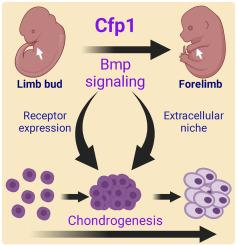CXXC Finger Protein 1 drives BMP signaling and progenitor cell differentiation during limb development
IF 2.1
3区 生物学
Q2 DEVELOPMENTAL BIOLOGY
引用次数: 0
Abstract
The mechanisms mediating endochondral bone formation remain incompletely understood. Here, we show that CXXC Finger Protein 1 (CFP1) is required for the onset of chondrogenesis during forelimb development. CFP1-deficient mesenchymal progenitor cells (LMPs) retain an immature molecular signature with elevated FGF and SHH signaling and repressed BMP signaling, in part, due to (1) reduced expression of type I BMP receptors, (2) reduced Smad1 protein levels and (3) an altered extracellular niche. Moreover, the addition of exogenous BMP ligand or antagonism of heparan sulfate restores LMP differentiation toward a chondrogenic fate and enhances BMP signaling, suggesting a defect in BMP ligand bioavailability mediates the CFP1-deficient LMP phenotype. Together, these findings define CFP1 as a gatekeeper between the undifferentiated and differentiated state of LMPs during endochondral bone formation and as a physiological regulator of BMP signaling.
Classification
Biological Sciences.

CXXC手指蛋白1在肢体发育过程中驱动BMP信号传导和祖细胞分化。
介导软骨内骨形成的机制仍不完全清楚。在这里,我们发现CXXC手指蛋白1 (CFP1)是前肢发育过程中软骨形成发生所必需的。cfp1缺失的间充质祖细胞(LMPs)保留了不成熟的分子特征,FGF和SHH信号升高,BMP信号抑制,部分原因是(1)I型BMP受体表达减少,(2)Smad1蛋白水平降低,(3)细胞外生态位改变。此外,外源性BMP配体的添加或硫酸肝素的拮抗可恢复LMP向软骨细胞分化并增强BMP信号传导,这表明BMP配体生物利用度的缺陷介导了cfp1缺陷的LMP表型。综上所述,这些发现将CFP1定义为软骨内骨形成过程中LMPs未分化和分化状态之间的看门人,并作为BMP信号传导的生理调节剂。分类:生物科学。
本文章由计算机程序翻译,如有差异,请以英文原文为准。
求助全文
约1分钟内获得全文
求助全文
来源期刊

Developmental biology
生物-发育生物学
CiteScore
5.30
自引率
3.70%
发文量
182
审稿时长
1.5 months
期刊介绍:
Developmental Biology (DB) publishes original research on mechanisms of development, differentiation, and growth in animals and plants at the molecular, cellular, genetic and evolutionary levels. Areas of particular emphasis include transcriptional control mechanisms, embryonic patterning, cell-cell interactions, growth factors and signal transduction, and regulatory hierarchies in developing plants and animals.
 求助内容:
求助内容: 应助结果提醒方式:
应助结果提醒方式:


